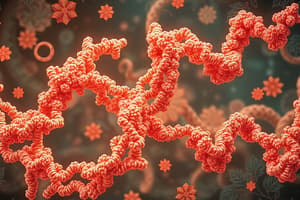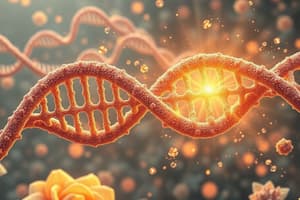Podcast
Questions and Answers
What is the start codon that signals the beginning of protein construction?
What is the start codon that signals the beginning of protein construction?
AUG
What is the main function of DNA translation?
What is the main function of DNA translation?
To convert genetic information into functional proteins
Which subunit of the ribosome initially binds to the 5' cap of mRNA during initiation?
Which subunit of the ribosome initially binds to the 5' cap of mRNA during initiation?
40s subunit
What happens during the elongation stage of DNA translation?
What happens during the elongation stage of DNA translation?
How does termination of translation occur?
How does termination of translation occur?
What happens to the polypeptide during termination of translation?
What happens to the polypeptide during termination of translation?
Flashcards are hidden until you start studying
Study Notes
DNA Translation
DNA translation is the second step in creating proteins following transcription in biology. It involves the conversion of the genetic information stored in deoxyribonucleic acid (DNA) into a functional protein. This process takes place in the cytoplasm of cells. Let's delve deeper into the intricacies of DNA translation.
Initiation
During the initiation phase, the ribosome binds to the start codon, usually represented by the sequence AUG, which signals the beginning of protein construction. At the 5' cap of mRNA, the smaller 40s subunit of the ribosome initially binds. Then, the larger 60s subunit binds, completing the initiation complex and allowing for translation to proceed.
Elongation
Elongation is the stage where the amino acid chain grows. The ribosome reads the mRNA one codon at a time. As each new codon becomes exposed, a matching tRNA binds to engage with the codon. The already existing amino acid chain (polypeptide) then links via a chemical reaction to the amino acid on the tRNA. The mRNA shifts one codon over, allowing for a new codon to be exposed for reading. This process is repeated until all the amino acids are added to the growing chain.
Termination
Termination signals the final stage of translation. When a stop codon, such as UAA, UAG, or UGA, enters the A site, no tRNAs bind to these codons. Consequently, the peptide and tRNA in the P site become hydrolyzed, releasing the polypeptide into the cytoplasm. Afterward, the small and large subunits of the ribosome dissociate, preparing them for another round of translation.
Components of Translation
Three main components are involved in DNA translation. Messenger RNA (mRNA) acts as the carrier of genetic information, while ribosomes function as the sites where polypeptides are constructed. Transfer RNAs (tRNAs) serve as adaptors, connecting the mRNA codons to the amino acids they encode.
Studying That Suits You
Use AI to generate personalized quizzes and flashcards to suit your learning preferences.




